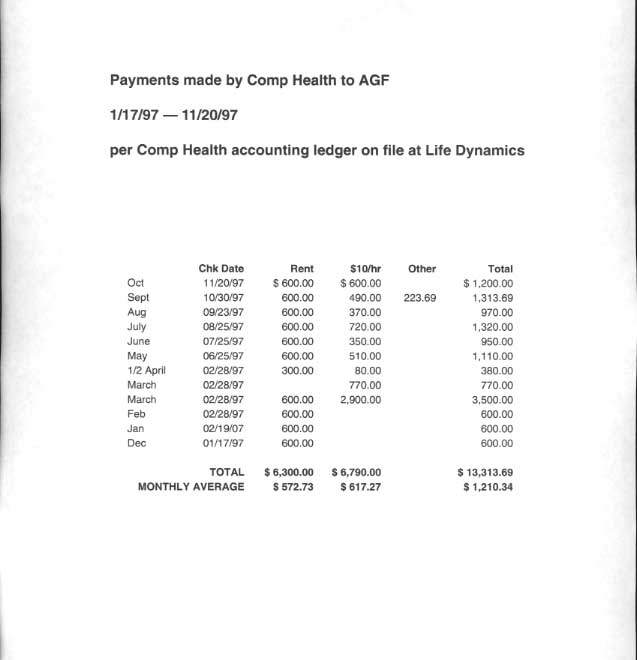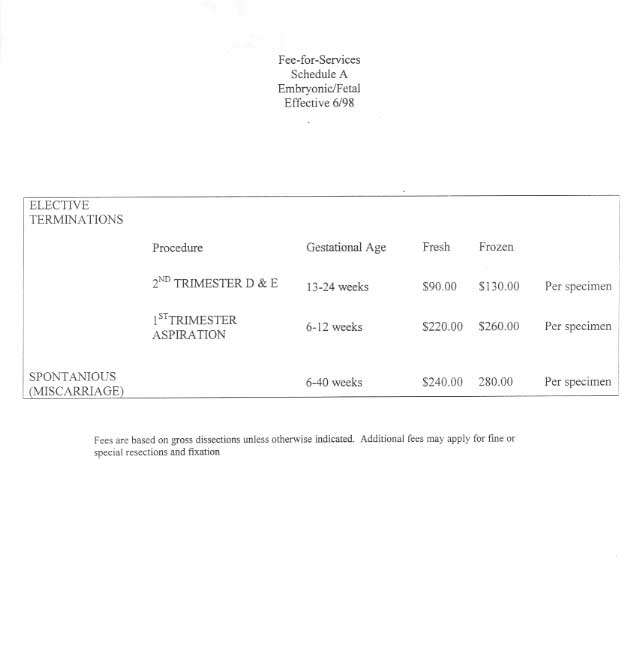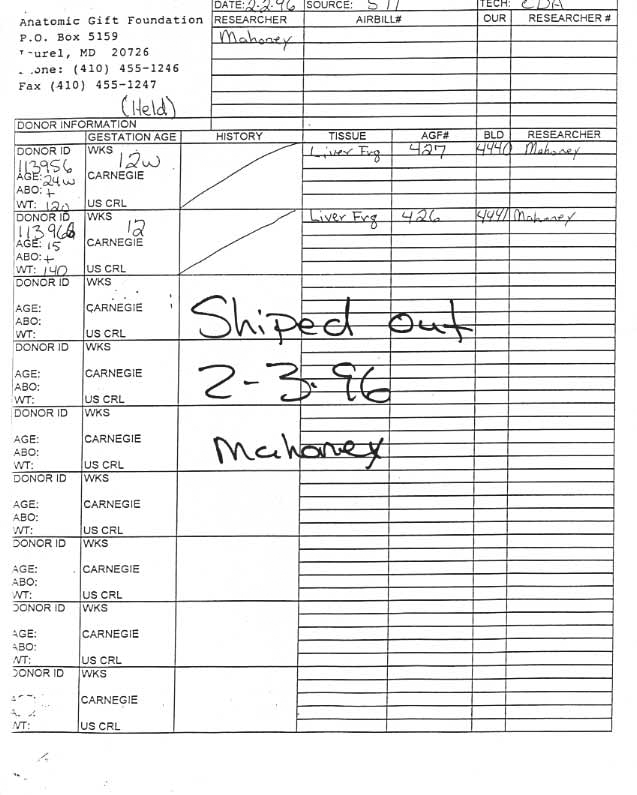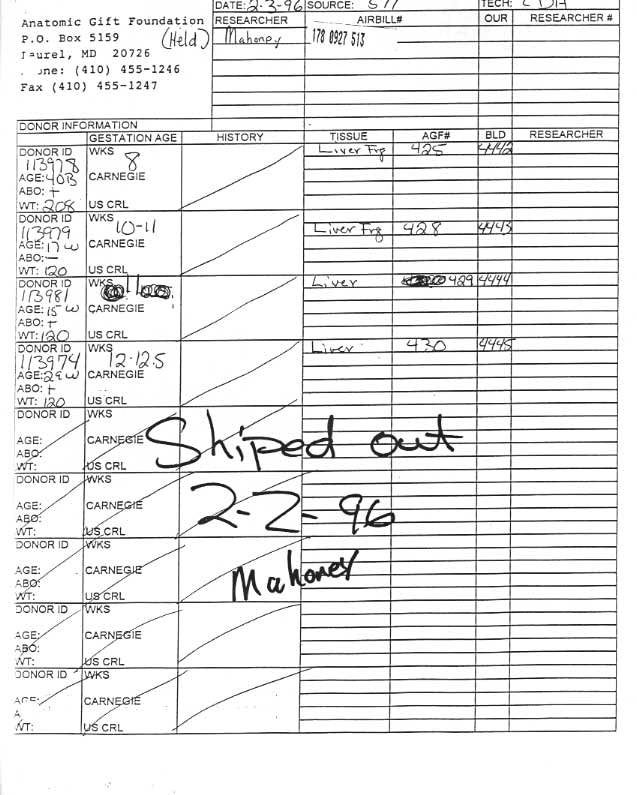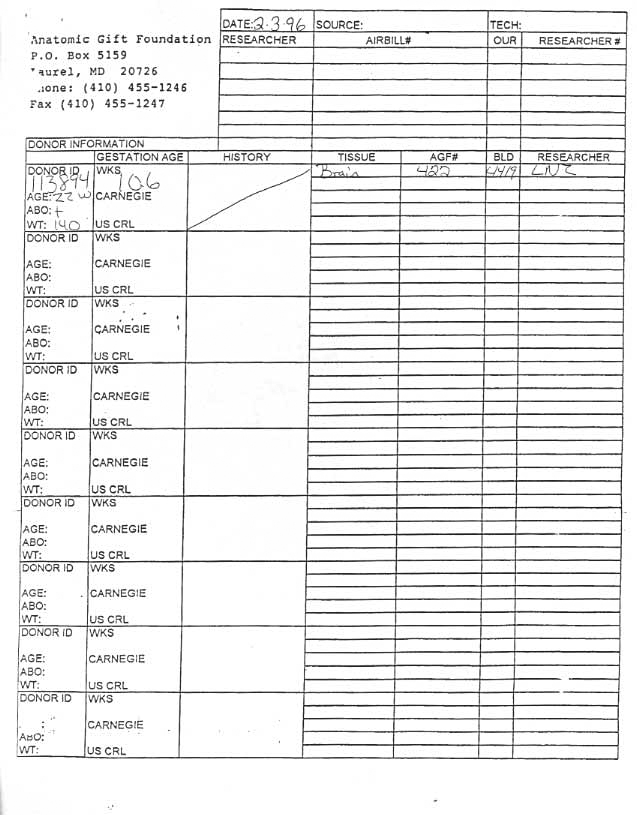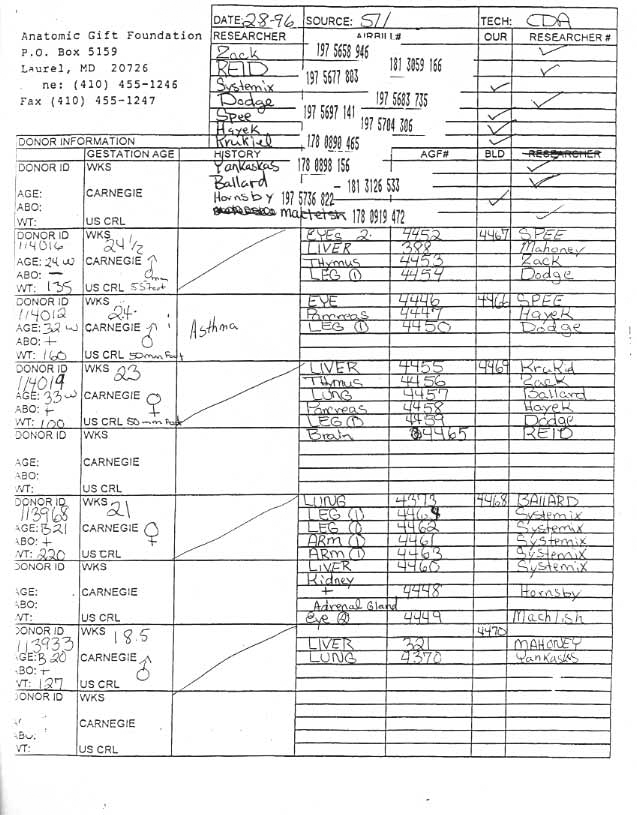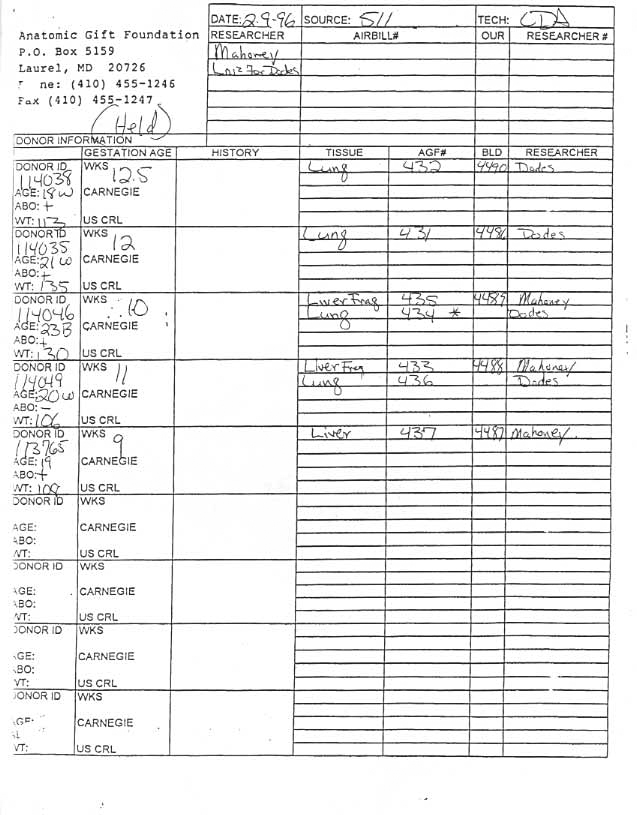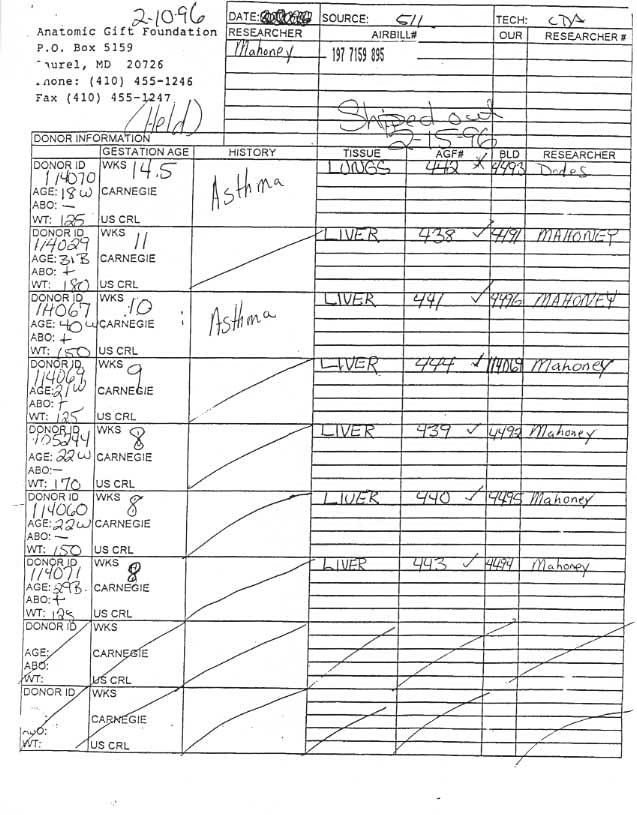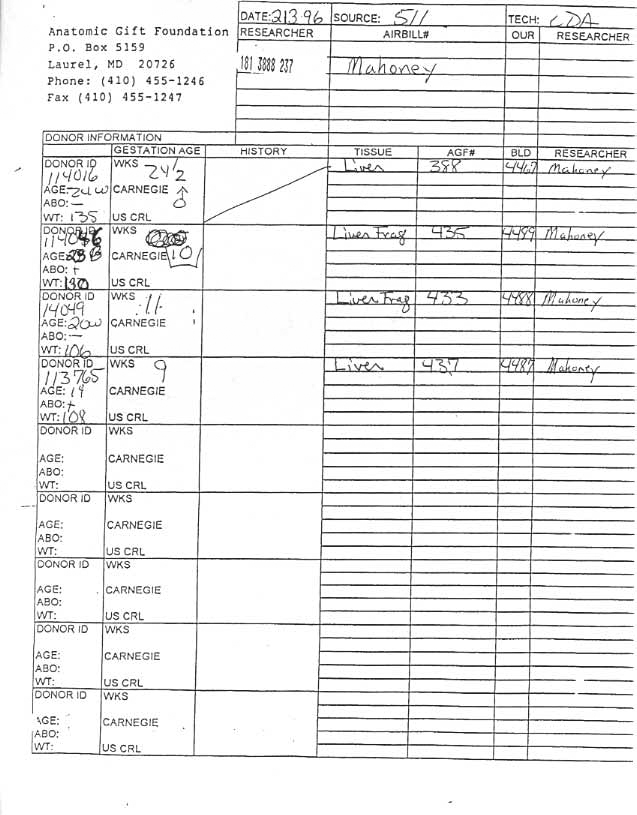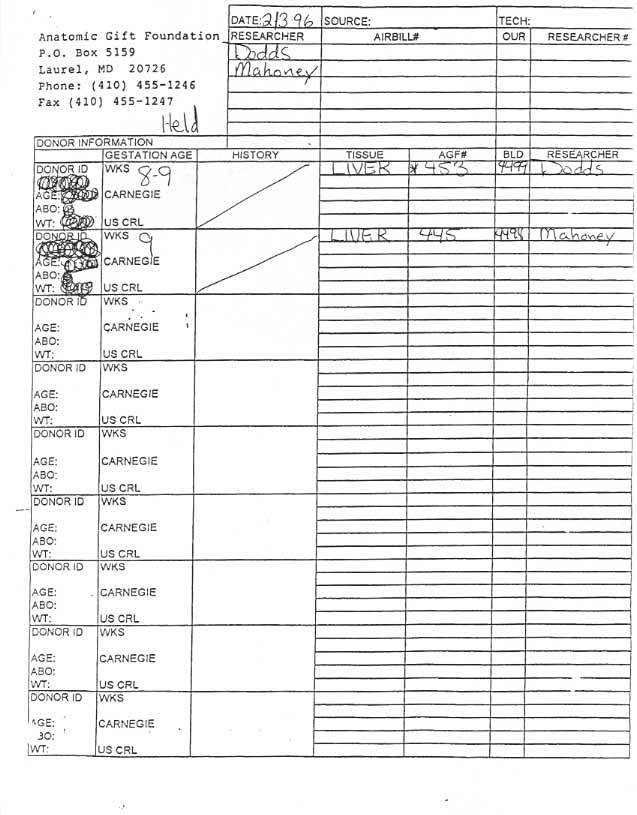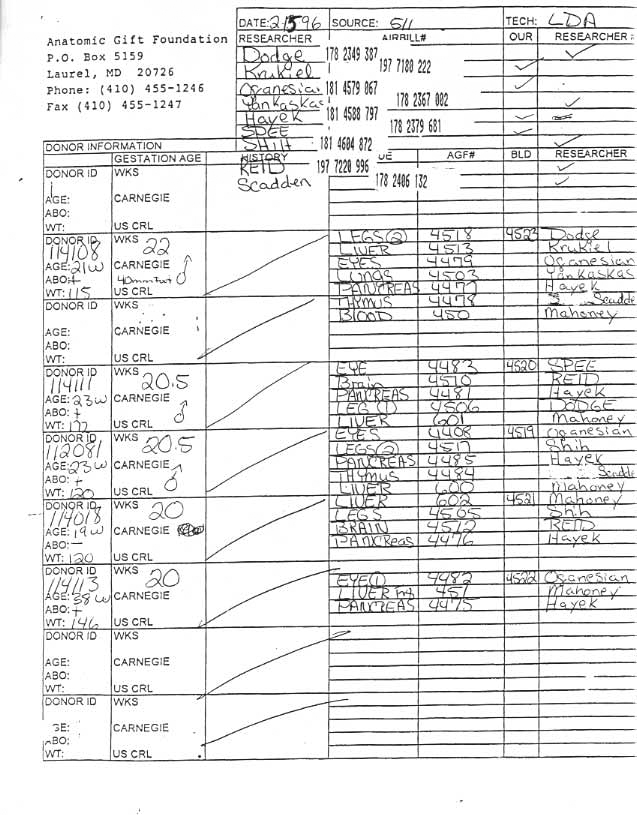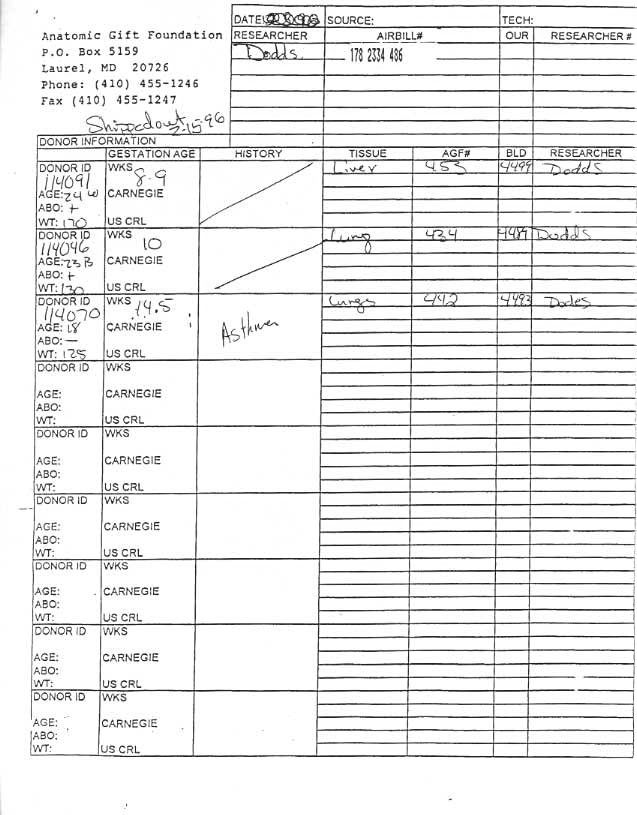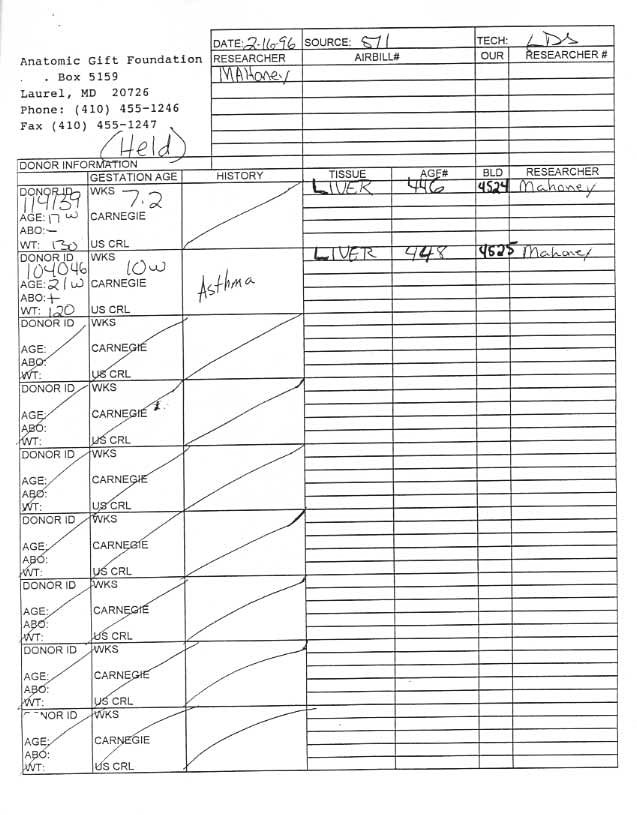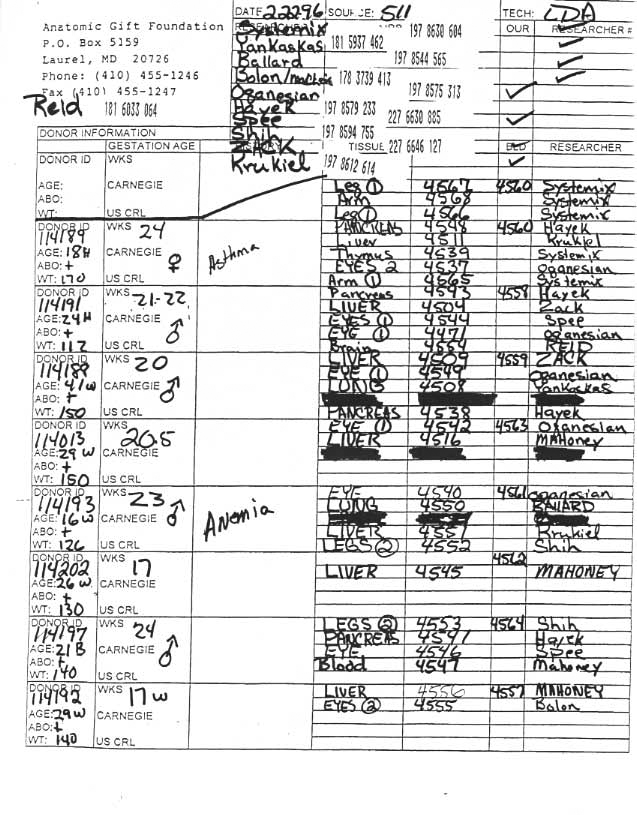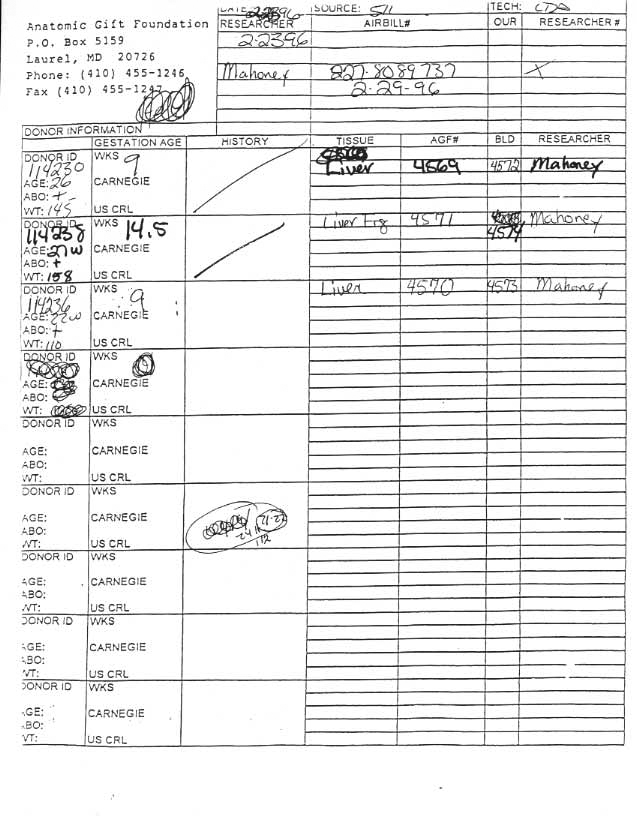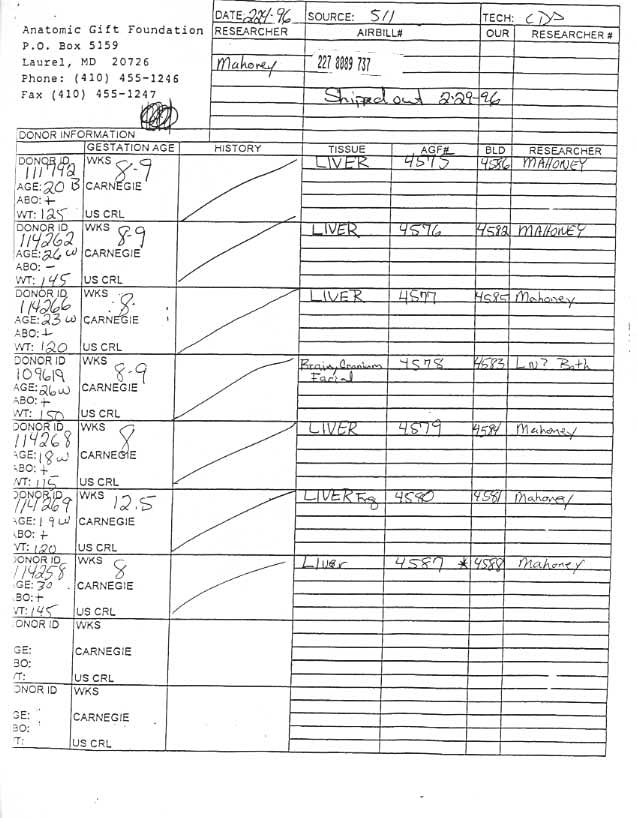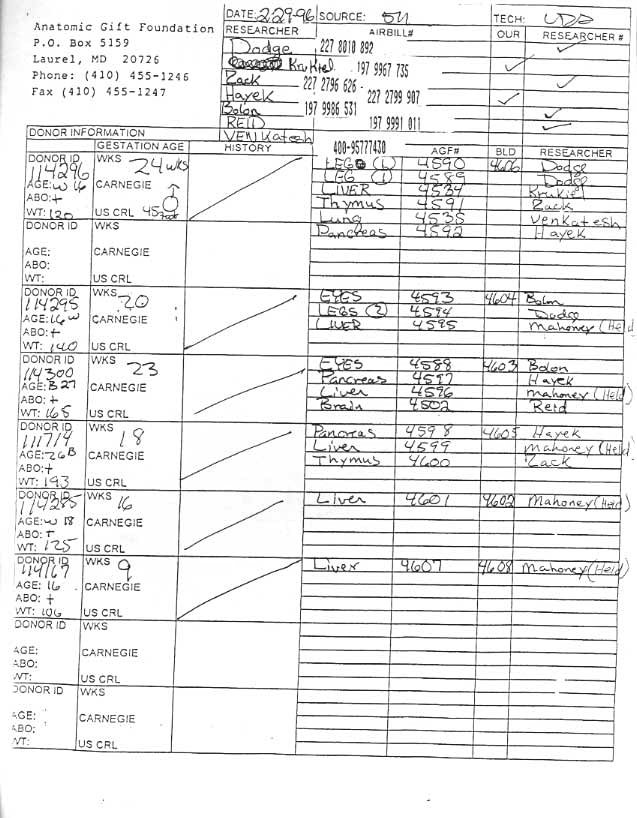The Money Trail
To demonstrate how profits are generated from the sale of baby parts, we began by compiling a chart of the payments made by AGF to Comp Health between December of 1996 and October of 1997. These figures were taken directly from Comp Health’s accounting ledger and are confirmed by their check book register showing that corresponding deposits were made from January to November of 1997. Copies of these two financial documents were given to us by an ex-employee of Comp Health. However, the ledger pages are so large that they would be unreadable if reduced to a size that would fit on a website. That is why we had to create this chart instead of simply including the ledgers themselves. Copies of the original ledgers are on file in our office.
An interesting item on the chart is the column titled “$10/hr.”
Figures listed under this heading reflect compensation for the time AGF’s retrieval technician was actually working inside Comp Health’s building.
If site fees are compensation for the actual costs associated with the retrieval process, the question becomes: what are these “$10/hr” payments for? After all, Comp Health did not incur any additional costs just because AGF’s technician walked in the door. That makes it implausible for payments reflected under the “$10/hr” column to be reimbursement for any actual costs associated with the retrieval of baby parts.
We have heard that AGF representatives are now claiming that the hourly fee is to cover blood work performed in association with the retrieval process.
There are at least three reasons why this explanation cannot be true. First, this is precisely the kind of expense that AGF claims its site fees are intended to cover. Second, medical procedures such as blood work are paid for by the incident, not by the hour. Third, and most important, blood work is a legitimate expense directly related to retrieval. As such, under normal accounting procedures this would be an itemized expense.
The point is, there is simply no logical basis for creating this nondescript accounting category for the purpose of including a legitimate expense.
So the question remains: What is the “$10/hr” category about?
The answer is obvious. AGF knows that it cannot legally pay for baby parts based on volume. However, they have logically assumed that the longer one of their retrieval technicians is at work the more tissue and parts are procured. Given that, a “per-hour” payment arrangement could be used as a substitute for payments based on volume. Some might argue that if Comp Health demanded more money, AGF could simply increase the site fee. However, as the chart shows, the site fee remains constant from month to month. That means if Comp Health experiences a bad month (low patient count, low donor rate, sub-standard tissue quality, etc.), AGF still pays the same site fee amount they pay during a good month. For AGF, imposing a higher site fee would simply exacerbate this situation. That may explain this “$10/hr” arrangement. In effect, it provides financial protection for AGF against high site fees during low-yield months, since AGF’s retrieval agent would be in Comp Health’s building fewer hours. Of course, this also gives Comp Health a financial incentive to keep patient counts and donation rates as high as possible.
In addition to the site fees, we know that AGF was paying the retrieval technician at this facility $10 an hour to harvest the tissue. Since abortions were only done on select days, it is highly unlikely he worked a standard 40-hour week, but to be safe we will assume that he did. Calculating $10 an hour over a 40-hour week and 52 weeks in a year, AGF was paying the retrieval technician who worked in the facility $1,733.33 a month.
Other costs AGF could legitimately recover would be those necessary to administer the project. It seems unrealistic that this would require an additional full-time employee. But again, for the purposes of this report we will assume that it did. We will also assume that this person was paid the same as the retrieval technician who worked at the clinic.
Finally, there are always miscellaneous costs associated with any operation requiring employees (matching FICA payments, health care insurance, etc.). Another item in the miscellaneous category would be the amortization of equipment (instruments, hood/ dissection table, etc.) plus the cost of disposable supplies necessary to retrieve baby parts. Being overly generous, we set the miscellaneous amount at $2,000 a month.
Combining all the retrieval costs listed in this section provides a figure that AGF could legitimately recover from researchers to whom it transferred baby parts. Billing amounts above that would indicate that these transactions were not donations, but sales. Keep in mind that, in every case where the actual amount is not known, we purposely and wildly exaggerated the estimates in favor of AGF.
Given that, the average monthly retrieval costs are:
| Site Fee (Rent) | $572.73 |
| $10/Hr Fee | $617.27 |
| Salaries (2 x $1,733.33) | $3,466.66 |
| Misc. | $2,000.00 |
| Total | $6,656.66 |
If AGF was complying with the laws against trafficking in baby parts, their fees for providing those parts should roughly correspond with the amount above. However, when we calculated how much AGF was invoicing its customers it became clear that this was not the case.
Getting that figure was possible because one of our undercover operatives provided us with a copy of AGF’s price list which they called a “Fee for Services.” We were also furnished daily log sheets for baby parts orders that were filled at Comp Health during February of 1996. (While there were only 17 log sheets representing 12 different dates, this clinic only does abortions on specific days during the week and these logs account for the entire month.)
In short, we simply took AGF’s internal log showing how many baby parts they sold in February of 1996 and priced out those logs using AGF’s own price list.
The “SOURCE” box at the top contains the AGF internal ID code, 511, which identifies Comp Health as the source clinic. The “TECH” box includes the notation “LDA” which are the initials of Lawrence Dean Alberty – the retrieval agent who worked for AGF inside Comp Health. Donor information includes the mother’s ID number, age and race (ex: 24W is a 24 year-old white woman), blood type (ex: ABO+), weight, plus the baby’s gestational age. In some cases, the dead baby’s sex was noted by a male or female symbol, and in some, the length of the baby’s foot is placed beside the line marked “US CRL.”
The notation “Tissue information” describes the type of part being shipped. A “FRG” designation means that the specimen was fragmented. The “AGF # ” is Anatomic Gift Foundation’s internal ID code for the tissue shipment, and “BLD” is their internal ID code for the maternal blood test. “Researcher” means the person ordering the part.
AGF Tissue Logs
According to these logs, during February of 1996, AGF sold the following parts from 69 different babies:
| 47 | Livers |
| 11 | Liver Fragments |
| 7 | Brains |
| 21 | Eyes |
| 8 | Thymuses |
| 23 | Legs |
| 14 | Pancreases |
| 14 | Lungs |
| 6 | Arms |
| 1 | Kidney/Adrenal Gland |
The above figures total 152 “specimens”. The logs show that they also sold the blood from three babies for a final specimen count of 155.
NOTE: According to the retrieval agent who harvested all of the parts listed above, in order for the blood of an aborted child to be sold, the dead baby had to be brought to him intact
According to their price list, AGF charges either $90 or $130 for a second-trimester specimen, and either $220 or $260 for a first-trimester specimen. The lower prices apply if the specimen is to be shipped fresh and the higher amount is used when it is shipped frozen. Whether a part is shipped fresh or frozen is not always reflected on the daily logs, therefore, we could not price these parts orders exactly and had to give a price range.
The tissue logs show that of the 69 babies dissected, there were 37 first-trimester babies which produced 39 specimens, and 32 second-trimester babies which produced 116 specimens. Using AGF’s price list reveals that the following amounts were charged to researchers for the parts listed:
| First-Trimester Specimens (39) | Minimum $8,580.0 |
| Maximum $10,140.00 | |
| Second-Trimester Specimens (113) | Minimum $10,170.00 |
| Maximum $14,690.00 | |
| Total For All Specimens (152) | Minimum $18,750.00 |
| Maximum $ 24,830.00 |
We were unable to find out how much AGF charges for baby blood, so the figures above do not include a cost for the three instances in which blood was sold. Since there is obviously some charge involved, if we had been able to include it AGF’s income would have risen by a corresponding amount.

